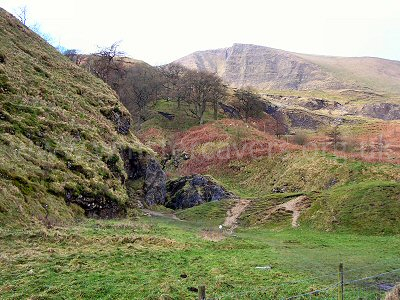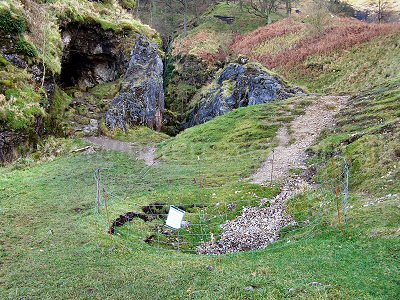Odin Mine, Derbyshire |
Odin Mine, a disused lead mine near Castleton, Derbyshire
WARNING - February 2011 - collapse and instability at Odin Mine
In February 2011 a team of cavers visiting Odin Mine discovered a collapse at the foot of the first handline climb. This by definition affects the passages and the cartgate beyond.
Various bodies are working together to assess and potentially the rememdy the situation - in the meantime cavers and mine explorers are asked to
PLEASE avoid the mine so as not to risk jeopardising future underground access.
For more detailed information see this document on the DCA web site.
Date:
25 December 2008
Overview:
Situated at the foot of Mam Tor, the "Shivering Mountain" in a spectacular setting, Odin Mine is worth a visit.
Odin Mine was formerly worked for lead, as were many of the Derbyshire mines. Across the road from the main entrance,
the remains of a crushing wheel and circular iron track bear testament to the site's lead mining legacy and have been
preserved by the National Trust, which has erected an interpretation plaque for visitors.
At the start of the open cut, close to the large entrance
of Odin Cave (a natural opening in the rock), a hole has recently opened up that is undoubtedly connected to the underground
workings. This is currently fenced off for safety and under observation to see what, if anything, develops.
Access:
Please see warning notice above and stay away until further information becomes available - thank you.
Parking:
By the roadside at the foot of Mam Tor near the bus turning circle (just before the road landslip).
Description:
The approach to Odin Mine is by walking up the right hand side of the open cut (not along the open cut itself).
The entrance can be descended using just a handline, or you can rig for SRT starting from the large tree you'll
encounter as you walk up the path. Rebelaying from a hanger over a rock lip drops you right by the entrance.
Inside the entrance further hangers enable an easy descent to be made to a grey and muddy passage. Tie off your rope
to the hanger at the base of the pitch to stop "helpful" (stupid) tourists pulling your rope up.
Past a muddy pool, you'll reach a slightly awkward climb up into a stope. There's a knotted and looped handline in place to
aid the climb. Both the climb and the rope are slippery, both being liberally coated in Odin's infamous "special" mud.
Stepping over one or two holes in the floor (traverse line useful for the less confident) leads to a pleasant pitch (~30') that lands on a steeply sloping floor.
Upslope leads to an array of scaffold and a dangerously unstable pitch of 125' to lower workings. In theory this is an area of great interest
and there are doubtless (re)discoveries that can me made here, but in practice this pitch is best avoided.
Downslope leads to further climbs down including the aptly-named "Chippendale Rift", with its table-leg
stemples of dubious vintage. Use a rope to protect the climb.
The passage is now of ample proportions and leads to the stunning cartgate with its partially arched roof, an
impressive piece of engineering and a clear indicator of the value of lead in bygone times.
|

The entrance ravine to Odin Mine. The approach path to the entrance goes over the
bracken-covered hillocks on the right of the cleft.

Odin Cave and the new collapse that has been fenced off by the National Trust
|
|